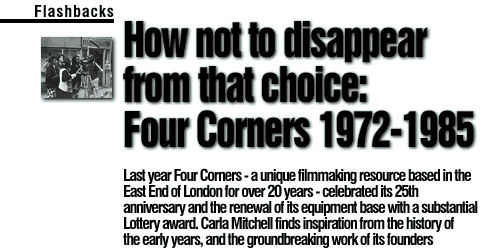
The early 1970s: flares and crushed velvet, cheesecloth shirts and lentil bake. The sexual revolution was under way, as childcare, housework and equal pay became political issues. The miners strike brought down Ted Heath’s Tory government. In radical circles the politics of 1968 were still hotly debated: art, revolution, the family were all up for discussion, and communal living the done thing.
Despite the work of Anderson, Loach and others, independent filmmakers were still relatively rare in the early 1970s and the audience for their films limited. 16mm cameras had begun to be used as a means of making low-budget films, and, inspired by the U.S underground movement of the early 1960s, radical filmmakers began to experiment with the aesthetics of film and the politics and practice of filmmaking.
The range of independent filmmaking work taking place divided into two broad areas: that of the explicitly politically-committed documentary, as produced by Cinema Action, Berwick Street Collective, Newsreel Group and others; and the ‘structuralist’ avant-garde, as represented by the London Filmmakers’ Coop. The relationship between these two tendencies was both productive and antagonistic, but as the decade progressed became increasingly polarised.
At the London Film School a group of four young filmmakers met and constituted themselves as Four Corner Films - loosely based on the fact that they came from all four corners of the world - in fact two were English, one German and one was from the U.S. Mary Pat Leece, Joanna Davis and Wilfried Thurst had gone to art school, while Ronald Peck came from a literary university background. Four Corners - as they became known - attempted to bridge the gap between politics and art, and bring films and filmmaking to those who had previously been excluded from the whole practice of film.
Their relationship to 1970s independent cinema was complex: Mary Pat Leece worked at the London Filmmakers’ Coop and Ron Peck at the Other Cinema - organisations almost diametrically opposed in their aims. The Coop was committed to an ‘avant-garde’ practice in which the formal elements of filmmaking were uppermost, while the Other Cinema was dedicated to showing politically-committed work, Third World cinema, as well as Godard, Rossellini, Bresson and others.
Four Corners sought to create room to experiment in filmmaking, and work in a collective, non-hierarchical way. They constituted a basic film unit, exchanging a variety of filmmaking roles. They drew on their collective backgrounds (fine arts, teaching and writing), and very distinct viewpoints, to arrive at their ideas through endless discussion, analysis and re-positioning in the style of the times. ‘Every piece of sound, every cut was worried to death’, according to a founder member. This method, they felt, could do justice to the complexity of their subject matter.
After film school they worked
at Space Studios on the Euston Road, and their first major 16mm projects, On
Allotments and Railman, were completed in 1976. On Allotments, an in-depth look
at a large allotment site in Newham, documented the visual contrasts of the
site and the popular aethestics of the allotment-holders. The imagery was conveyed
through slow, contemplative panning shots, a carefully structured sound-track
and particularly beautiful greens (the filmmakers insisted on three regradings).
It was critically acclaimed. Monthly Film Bulletin described its style as “lying
somewhere between Jenning’s Spare Time and the current British landscape
genre of Chris Welsby… one of the most interesting examples of recent British
independent filmmaking, coming to terms with the Griersonian documentary heritage
and inflecting it through a recognisably contemporary aesthetic.”
In formalistic terms, Four Corners as represented through films like On Allotments
was close to the Coop’s avant-gardism (one review described “a dissolve
to a lateral shot of rhubarb-stalks”) - but differed in that they were
committed to representational forms, and had a strong interest in the material
reality of everyday life. They never defined themselves in the ‘agit prop’
sense of Cinema Action or the Newsreel Group, nor in the structuralist manner
of Malcolm LeGrice. Believing their definitions should come through what they
produced - they would not adhere to a set of cut-and-dried principles. As a
result their rather subtle work was often seen as hard to place, and they came
in for much criticism, especially from the more directly politically-committed
groups.
On Allotments was a case in point. During the filming, the allotment sites were threatened by development of a continental lorry park. Campaign meetings were held, and Prime Minister Harold Wilson petitioned. This, argued the Newsreel Group, was precisely the kind of campaign the film should support. Four Corners chose not to: it was not central to the concerns of the film as they had been conceived. After much discussion, the allotment campaign was acknowledged within the film, but was not its main focus. The decision was not lightly arrived at. Like every shot, juxtaposition and framing, exactly how much detail on the campaign to include was debated at great length.
This experience set the context for a number of films which sought a never unproblematic experimentation in filmmaking. As a group statement in 1978 put it: “It has always been difficult to place our work within the current poles of ‘agitprop’ and narrative filmmaking and experimental ‘structuralist’ filmmaking... but we are generally interested in making films in which the subject matter is stretched by the formal structure of the film - films which aim at challenging people’s preconceptions of what films are in order to encourage an active participation in what the film is about.”...
Carla Mitchell, 1998
With many thanks to: Jo Davis, Ron Peck and Wilf Thurst, and in fond memory
of Mary Pat Leece
Full article published in Filmwaves - Issue 4, Spring 1998. Subscribe now!